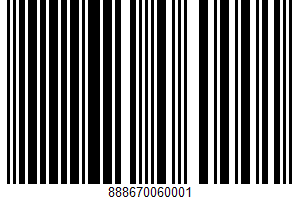Chicken Salad - 130 calories
Manufacturer Bj's Wholesale Club / Corporate Brands
Product Information and Ingredients
Chicken Salad is manufactured by Bj's Wholesale Club / Corporate Brands with a suggested serving size of 1 4OZ PACK (113 g) and 130 calories per serving. The nutritional value of a suggested serving of chicken salad includes 31 mg of cholesterol, 0 mg of sodium, 12 grams of carbohydrates, 1 grams of dietary fiber, 9 grams of sugar and 13 grams of proteins.
The product's manufacturer code is UPC: 888670060001.
Calories from fat: a total of 24.23% of the calories in the suggested servig of this product come from fat.
Ingredient List
- Chicken Breast (chicken Breast With Rib Meat
- Chicken Broth
- Sea Salt
- Rice Starch)
- Low-fat Greek Yogurt (grade A Pasteurized Skim Milk
- Milk Protein Concentrate
- Cream
- Pectin
- Enzymes
- Live Active Cultures)
- Celery
- Onions
- Sweetened Dried Cranberries (cranberries
- Sugar
- Sunflower Oil)
- Apple Cider Vinegar
- Raw Cane Sugar
- Roasted Almonds
- Sea Salt
- Poppy Seeds
- Xanthan Gum
- Black Pepper

Nutrition Facts
Serving Size 1 4OZ PACK (113 g)
| Amount Per Serving | ||
|---|---|---|
| Calories 130 | Calories from Fat 32 | |
| % Daily Value* | ||
| Total Fat 3.5g | 6% | |
| Saturated Fat 0.5g | 3% | |
| Trans Fat 0g | ||
| Cholesterol 31mg | 12% | |
| Sodium 0mg | 0% | |
| Total Carbohydrate 12g | 5% | |
| Dietary Fiber 1g | 5% | |
| Sugars 9g | ||
| Protein 13g | ||
| Vitamin A 0% | Vitamin C 0% |
| Calcium 8% | Iron 4% |
* Percent Daily Values are based on a 2,000 calorie diet.
Nutrition Facts
Serving Size 100g (about 3.52 oz)
| Amount Per Serving | ||
|---|---|---|
| Calories 115 | Calories from Fat 28 | |
| % Daily Value* | ||
| Total Fat 3.1g | 5% | |
| Saturated Fat 0.4g | 2% | |
| Trans Fat 0g | ||
| Cholesterol 27mg | 10% | |
| Sodium 265mg | 12% | |
| Total Carbohydrate 10.6g | 4% | |
| Dietary Fiber 0.9g | 4% | |
| Sugars 8g | ||
| Protein 12g | ||
| Vitamin A 0% | Vitamin C 0% |
| Calcium 7% | Iron 3% |
* Percent Daily Values are based on a 2,000 calorie diet.
Chicken Salad Nutritional Value
| Nutrient | Suggested Serving 1 4OZ PACK (113 g) | Standard Serving 100g |
|---|---|---|
| Energy | 130 kcal (7%) | 115 kcal (7%) |
| Protein | 12.99 g (29%) | 11.5 g (25%) |
| Total Lipid (fat) | 3.5 g (6%) | 3.1 g (5%) |
| Carbohydrate, By Difference | 12 g (5%) | 10.62 g (4%) |
| Fiber, Total Dietary | 1 g (5%) | 0.9 g (4%) |
| Sugars, Total | 8.99 g (41%) | 7.96 g (36%) |
| Calcium, Ca | 90 mg (8%) | 80 mg (7%) |
| Iron, Fe | 0.6 mg (4%) | 0.53 mg (3%) |
| Sodium, Na | 299 mg (14%) | 265 mg (12%) |
| Vitamin D | 0 IU (0%) | 0 IU (0%) |
| Fatty Acids, Total Saturated | 0.5 g (3%) | 0.44 g (2%) |
| Fatty Acids, Total Trans | 0 g (0%) | 0 g (0%) |
| Cholesterol | 31 mg (12%) | 27 mg (10%) |
Calories Burn off Time
How long would it take to burn off Bj's Wholesale Club / Corporate Brands Chicken Salad with 130 calories? A brisk walk for 28 minutes, jogging for 13 minutes, or hiking for 22 minutes will help your burn off the calories in chicken salad.
Burn off time varies based on your weight, physical activity and exercise intensity. The following physical activity table contains an estimated burn off time for a person weighting 154 lbs.
| Physical Activity | Burn Off Time |
|---|---|
| Bicycling - 10 mph or less | 27 minutes |
| Dancing | 24 minutes |
| Golfing | 24 minutes |
| Hiking | 22 minutes |
| Light Gardening | 24 minutes |
| Stretching | 43 minutes |
| Walking - 3.5 mph | 28 minutes |
| Weight Training - light workout | 36 minutes |
| Aerobics | 16 minutes |
| Basketball | 18 minutes |
| Bicycling - 10 mph or more | 13 minutes |
| Running - 5 mph | 13 minutes |
| Swimming | 15 minutes |
| Walking - 4.5 mph | 17 minutes |
| Weight Training - vigorous workout | 18 minutes |
Footnotes
Percent daily values are based on a 2,000 calorie reference diet. Factors like age, gender and level of physical activity may affect your daily required values.
The editorial opinions regarding food value or quality in this website are given without warranty, and are not intended to replace medical advice or a nutritionist guidance.
Dietary Recommendations
A healthy eating pattern that accounts for all foods and beverages within an appropriate calorie level could help achieve and maintain a healthy weight and reduce the risk of chronic disease. Healthy eating habits include the following:
- Vegetables from all subgroups, including dark, green, red and orange vegetables and also beans and peas
- A variety of whole fruits
- Grains with at least half of which are whole grains
- Low or fat free dairy products, including milk, yogurt, cheese and/or fortified soy beverages
- Protein foods, including seafood, lean meats and poultry, eggs and nuts
- Oils with limited amounts of saturated fats and trans fats, added sugars, and sodium
